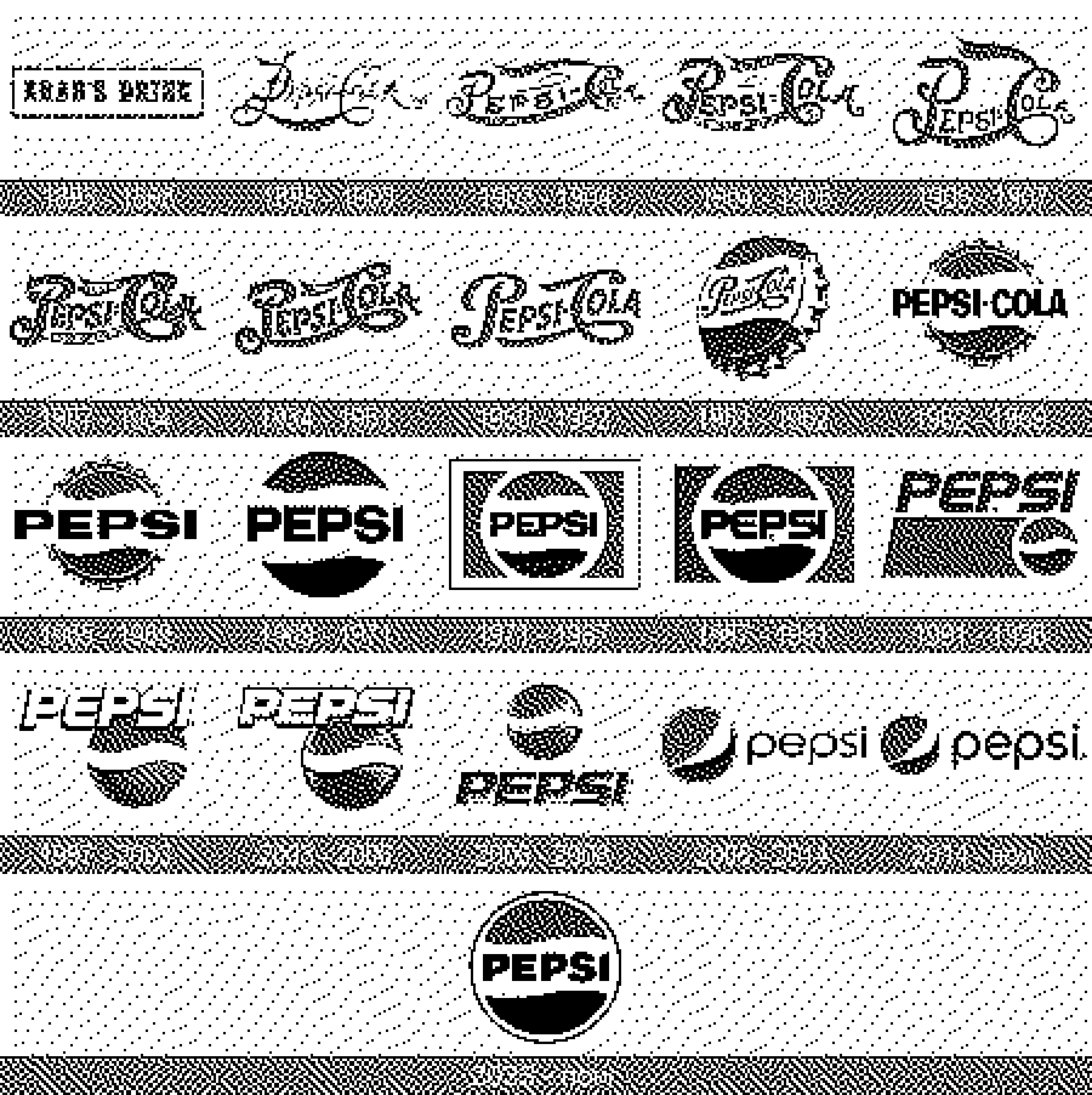Oftentimes, when a major new logo design is released, we witness a familiar pattern: an uproar online as people take to social media to express their outrage or approval. Notable examples over the years include the Gap logo redesign1 in 2010 by Arnell Partners; the London 2012 Olympics branding2 by Wolf Olins (along with the unfairly maligned Tokyo 2020 Olympics logo3 by Kenjiro Sano); and Twitter’s fascist turn signaled by a crowdsourced “X” logo in 2023. But logos are not solely the domain of large corporations or organizations like these; they are a fundamental aspect of our visual language, used by groups and individuals alike as a meaningful expression of identity. Why do logos solicit such a strong reaction online, especially when graphic designers feel like they have fallen short of their aesthetic potential?
Is it only within a culture that fetishizes corporate branding that logos have become so visually banal and empty? Or does this dilution stem from something deeper?
To understand the roots of logo design’s descent into homogeny, we must return to branding’s origins. While visual symbology has existed since the Neaderthals, western design’s aesthetic connection to the industrial age is often credited to German architect, graphic, and industrial designer Peter Behrens. Although there were previously existing trademarks, many say that Behrens created the first complete branding system in 1907 for the electric company Allgemeine Elektricitäts-Gesellschaft (AEG)—one of the largest manufacturing companies in the world at the time—through logo, posters, architecture, and product design.* In addition to his graphic and architectural practice, he is known for mentoring Le Corbusier, Mies van der Rohe, and Walter Gropius (who later founded the Bauhaus, which many consider to be the foundation of today’s Western art education system). Behrens’ work represents a clear break from the prevalent Arts and Crafts movement of his time, favoring streamlined forms over ornate aesthetics. Later in life, he found favor with Adolf Hitler, who commissioned him to design AEG’s new headquarters in Berlin, where Behrens died in 1940.
Is it only within a culture that fetishizes corporate branding that logos have become so visually banal and empty? Or does this dilution stem from something deeper?
To understand the roots of logo design’s descent into homogeny, we must return to branding’s origins. While visual symbology has existed since the Neaderthals, western design’s aesthetic connection to the industrial age is often credited to German architect, graphic, and industrial designer Peter Behrens. Although there were previously existing trademarks, many say that Behrens created the first complete branding system in 1907 for the electric company Allgemeine Elektricitäts-Gesellschaft (AEG)—one of the largest manufacturing companies in the world at the time—through logo, posters, architecture, and product design.* In addition to his graphic and architectural practice, he is known for mentoring Le Corbusier, Mies van der Rohe, and Walter Gropius (who later founded the Bauhaus, which many consider to be the foundation of today’s Western art education system). Behrens’ work represents a clear break from the prevalent Arts and Crafts movement of his time, favoring streamlined forms over ornate aesthetics. Later in life, he found favor with Adolf Hitler, who commissioned him to design AEG’s new headquarters in Berlin, where Behrens died in 1940.

Various Designers, Pepsi Logo Designs, 1893–present
The origins of branding in fascism are not a product of mere coincidence. Although the Bauhaus members whom Behrens mentored diverged ideologically from his work, the union of art and industry helped give rise to a class hierarchy dictated by aesthetics. Modernism assigned value to items where value didn’t exist, replicating machine-made objects for the masses and assigning value to items disparate from their intrinsic quality, all while concealing the labor that went into making them. Despite modernism’s reductive forms, it eventually became synonymous with luxury, making good design a private privilege primarily afforded to the upper class. In America, designers inspired by the Bauhaus such as Paul Rand and Chermayeff & Geismar brought together form and finance, designing logos for countless companies while championing improvements in everyday life through design. This period marked a renaissance of aesthetics in corporate America, with the foundational teachings of the Bauhaus permeating offices, banks, and grocery stores. To these designers, modernism represented a methodical approach using systems and grids, an ideal that prioritized clear communication and efficiency, and a strategy designed to facilitate convenience and effectiveness in postwar industrial, technological, and democratic societies. In Paul Rand’s words:4 “(Modernism) means integrity; it means honesty; it means the absence of sentimentality and the absence of nostalgia; it means simplicity; it means clarity.” Modernist aesthetics undoubtedly improved the lives of many and injected beauty into everyday life, and the mid-century to the end of the millennium is often considered to be graphic design’s golden age. But it also lined the pockets of the rich, widening the income gap while indirectly exploiting citizens of all classes through type and image.
This reductive history isn’t to say that all logos are bad. In fact, quite the opposite is true, as many visual symbols have been the basis of everything from community to revolution. Graphics have long been used throughout history in political, artistic, and labor movements, visually uniting communities through form and language—from the peace symbol ☮ (designed by Gerald Holtom for the British Campaign for Nuclear Disarmament in 1958)5 to the transgender flag 🏳️⚧️ (created by American transgender activist Monica Helms in 1999).6 It can only be assumed that modernists genuinely thought they were improving the world through aesthetics, and in many ways, they did, but they were powerless against capitalism’s exploitation and downward slide into aesthetic and cultural erosion.
This reductive history isn’t to say that all logos are bad. In fact, quite the opposite is true, as many visual symbols have been the basis of everything from community to revolution. Graphics have long been used throughout history in political, artistic, and labor movements, visually uniting communities through form and language—from the peace symbol ☮ (designed by Gerald Holtom for the British Campaign for Nuclear Disarmament in 1958)5 to the transgender flag 🏳️⚧️ (created by American transgender activist Monica Helms in 1999).6 It can only be assumed that modernists genuinely thought they were improving the world through aesthetics, and in many ways, they did, but they were powerless against capitalism’s exploitation and downward slide into aesthetic and cultural erosion.

Arnell Group’s “Design Strategy” for the launch of Pepsi’s new logo, 2008
There is no better example of the historical degradation of branding than the design history of the noted soft drink company, Pepsi. In the Pepsi logo, we can trace most trends in post-Industrial Revolution graphic design, from the Arts and Crafts movement (circa 1860–1920s) to modernism (early 20th century–1970s), postmodernism (1970s–90s), and the current era of algorithmic aesthetics in the Anthropocene along with a present-day callback to past design with Pepsi’s current logo. You can see a clear visual shift due to technology and tastes of the time, from ornate forms in the early 1900s to reductive modernist sans serif typography in the middle of the century, all the way to basic shapes and gradients collaged with previously designed typefaces in the 1990s thanks to the rise of Adobe which eliminated the need for hand drawing. This latest technological shift marked a new era of postmodernism, where aesthetics flourished with beauty, a renewed emphasis on personal expression emerged, and the modernist attempt at objectivity was rejected. However, most corporate branding remained philosophically rooted in modernism—championing clarity and usability for all—but lacked the technical skill of its modernist forebears. Most modernist logo designers created their own logos and typefaces (or oversaw designers who did), requiring a deep understanding of visual weight and space, a skill that gradually faded out with the rise of postmodern digital design. In his advice to his students, the legendary Modernist designer Saul Bass once said in the wake of this degradation of aesthetics, simply: “Learn to draw!”7

Peter Behrens, Allgemeine Elektricitäts-Gesellschaft logo, 1908
The Pepsi-flavored Rosetta Stone of this aesthetic phenomenon was unveiled when the curtain was pulled back on Pepsi’s design process in the 2008 leak of Arnell Group’s “Design Strategy” for the launch of Pepsi’s new logo.8 The PDF is a masterclass in bullshit, drawing comparisons between the design and the Mona Lisa while claiming that the new identity possesses its own “gravitational pull.” In this Pepsi Universe, actual graphic design is pushed to the sidelines, and by the time the PDF reaches its conclusion, the big reveal—in graphic form—is that the logo is simply made of smiley faces. Graphic design isn’t exactly rocket science, but in this document, the design process is both erased and somehow elevated to the actual heights of rocket science, philosophy, and even metaphysics. What this PDF reveals is that the practice of graphic design was taken from designers long ago—at least in larger corporate settings—and handed over to marketing departments, creative directors, and advertising agency CEOs. The bygone modernist era of Paul Rand and Chermayeff & Geismar is long dead, the post-modernist personal expression experiment failed, and we are now deeply entrenched in the age of neoliberal design bullshit, drowning in a sticky-sweet Pepsi-flavored swamp.
Nowadays, branding often operates this way, primarily in advertising and at larger design agencies. The process often goes as follows: when a design team is assigned a logo (and ideally not forced to pitch against other designers), the work is handed off to underpaid and overworked junior designers and interns. They are tasked with pulling from a mood board, replicating existing design work, and churning out hundreds of options, often using slightly tweaked pre-designed fonts that are poorly set. Then, a creative director looks at the printouts, points to a few options, and the logos get refined and placed in a deck. The deck is then piled on with copy, sometimes up to hundreds of pages of written justifications for a logo padded with mockups on tote bags, coffee cups, and stickers (theoretical garbage for future landfills adorned with the company’s logo). Countless meetings follow (often excluding the actual designers of the logos), and budgets can soar into the millions until the client ends up with a logo that makes everyone happy but fails to communicate anything meaningful. This process isn’t limited to large design agencies; it can also occur within internal corporate teams or get fragmented across smaller marketing and design agencies, where the actual design work is handed off to smaller and smaller teams.
But there are exceptions. The Nike logo was designed by Carolyn Davidson, a graphic design student at Portland State University who met Nike founder Phil Knight at the college. Due to tight deadlines, there was only one round of presentations before the logo made its way onto sneakers. Similarly, the seminal logo for the equally seminal punk band Black Flag was conceived and drawn by guitarist Greg Ginn’s brother, artist Raymond Pettibon. In Michael Azerrad’s Our Band Could be Your Life the logo is described9 as “If a white flag means surrender, it was plain what a black flag meant; a black flag is also a recognized symbol for anarchy.” Milton Glaser’s original “I Love New York” logo was designed in 1976 in the back of a cab with a red crayon on scrap paper. In the words of Gloria Steinem,10 “Milton Glaser’s designs changed the way we see the world. From books, record covers, to I♥NY, he moved design from the elite to the universal.” What ties these experiences together is their authenticity, either working with conditions that circumvent our current system or a personal connection to who and what it is they are designing for. That’s not to say these logos aren’t used for exploitation. Nike, for example, has famously long evaded acknowledging the sweatshops that produce the sneakers displaying its famous swash. These days, corporate branding mirrors our algorithmic feeds—ceaseless, cold, and calculated—and is far removed from a time when designers primarily worked directly with the people they were creating logos for, regardless of the organization’s size. But this might be exactly what large companies deserve. The late-stage capitalist creation of bullshit jobs and endless meetings hasn’t spared graphic design and graphic design shouldn’t spare corporations, either.
Nowadays, branding often operates this way, primarily in advertising and at larger design agencies. The process often goes as follows: when a design team is assigned a logo (and ideally not forced to pitch against other designers), the work is handed off to underpaid and overworked junior designers and interns. They are tasked with pulling from a mood board, replicating existing design work, and churning out hundreds of options, often using slightly tweaked pre-designed fonts that are poorly set. Then, a creative director looks at the printouts, points to a few options, and the logos get refined and placed in a deck. The deck is then piled on with copy, sometimes up to hundreds of pages of written justifications for a logo padded with mockups on tote bags, coffee cups, and stickers (theoretical garbage for future landfills adorned with the company’s logo). Countless meetings follow (often excluding the actual designers of the logos), and budgets can soar into the millions until the client ends up with a logo that makes everyone happy but fails to communicate anything meaningful. This process isn’t limited to large design agencies; it can also occur within internal corporate teams or get fragmented across smaller marketing and design agencies, where the actual design work is handed off to smaller and smaller teams.
But there are exceptions. The Nike logo was designed by Carolyn Davidson, a graphic design student at Portland State University who met Nike founder Phil Knight at the college. Due to tight deadlines, there was only one round of presentations before the logo made its way onto sneakers. Similarly, the seminal logo for the equally seminal punk band Black Flag was conceived and drawn by guitarist Greg Ginn’s brother, artist Raymond Pettibon. In Michael Azerrad’s Our Band Could be Your Life the logo is described9 as “If a white flag means surrender, it was plain what a black flag meant; a black flag is also a recognized symbol for anarchy.” Milton Glaser’s original “I Love New York” logo was designed in 1976 in the back of a cab with a red crayon on scrap paper. In the words of Gloria Steinem,10 “Milton Glaser’s designs changed the way we see the world. From books, record covers, to I♥NY, he moved design from the elite to the universal.” What ties these experiences together is their authenticity, either working with conditions that circumvent our current system or a personal connection to who and what it is they are designing for. That’s not to say these logos aren’t used for exploitation. Nike, for example, has famously long evaded acknowledging the sweatshops that produce the sneakers displaying its famous swash. These days, corporate branding mirrors our algorithmic feeds—ceaseless, cold, and calculated—and is far removed from a time when designers primarily worked directly with the people they were creating logos for, regardless of the organization’s size. But this might be exactly what large companies deserve. The late-stage capitalist creation of bullshit jobs and endless meetings hasn’t spared graphic design and graphic design shouldn’t spare corporations, either.

Milton Glaser, I ♥ NY concept sketch, 1976
If we are to reclaim logos from the committees and agencies, we must break free from the grip of neoliberalism and rediscover our artistic and cultural value. Branding is a true art form and that becomes lost when good design is ground down into endless revisions and marketing newspeak. The designer(s) behind the logo should always be present in meetings with the client, and endless decks with nonsense writing should be deleted. This is not to say that logo design shouldn’t be justified in presentations. Rather, designers should be able to articulate their research, concepts, and designs directly to the client. If they are unable to do so, they should work closely with copywriters or producers who can, as expecting clients to speak the same language or inherently understand good aesthetics would be a fool’s errand. And if graphic designers wish to pursue branding, they should show an interest in learning how to draw type and form—or try to work directly with type designers, if possible—as a close understanding of letterforms and shapes is branding’s greatest asset and will prevent the mushing together of random shapes, bad typography, and meaningless mockups.
Despite all the bad branding out there, it’s worth mentioning that there are several small studios and cultural institutions that are actively applying the methods outlined here to conceptualize and produce smart and meaningful branding work. While their work is important, the public deserves more beauty, and branding at all levels needs to be improved. With this in mind, we can begin to revitalize logo design as a true artistic expression rather than a hollow corporate exercise.
* Or as Philip B. Meggs’ Meggs’ History of Graphic Design stated, “His work for the Allgemeine Elektrizitäts-Gesellschaft, or AEG, is considered the first comprehensive visual identification program.”
Despite all the bad branding out there, it’s worth mentioning that there are several small studios and cultural institutions that are actively applying the methods outlined here to conceptualize and produce smart and meaningful branding work. While their work is important, the public deserves more beauty, and branding at all levels needs to be improved. With this in mind, we can begin to revitalize logo design as a true artistic expression rather than a hollow corporate exercise.
* Or as Philip B. Meggs’ Meggs’ History of Graphic Design stated, “His work for the Allgemeine Elektrizitäts-Gesellschaft, or AEG, is considered the first comprehensive visual identification program.”